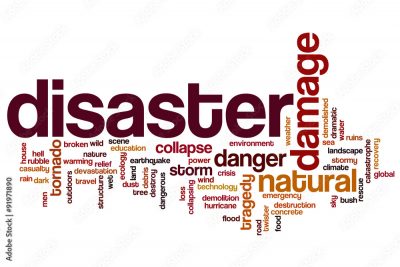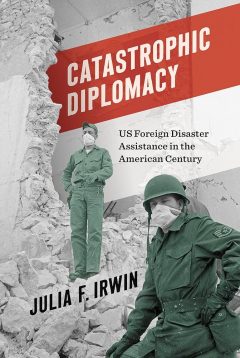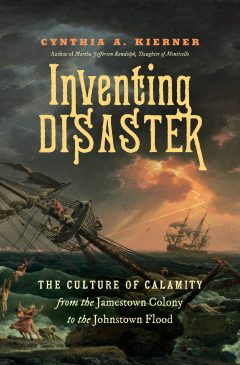What is a Disaster?

At a recent Disaster Lab meeting, the question of “what is a disaster?” came up. We realized that despite researching how other people were thinking about, addressing, and/or experiencing disasters our project team had yet to define the term for our own purposes. As we set about doing so, we recognized that (as is the case with so many projects) our sense of what constitutes a disaster has become more subjective and relational the more that we learn about the ways in which communities have experienced disasters and displacement historically.
The Oxford English Dictionary defines a disaster as “An event or occurrence of a ruinous or very distressing nature; a calamity; esp. a sudden accident or natural catastrophe that causes great damage or loss of life.” This is a tidy definition that seemingly captures the essence of what constitutes a disaster; something unexpected, something upsetting and potentially life-altering or life-ending, and something beyond any one victim’s control.
However, this tidy definition fails to reveal the many ways in which the notion of a disaster is contested because there is so much at stake. To name something a disaster is to call attention to its tragic proportions, either human, material, or environmental. We see this in the language around climate change, which has shifted from emergency, to disaster, and now catastrophe, or apocalypse. Returning to the Oxford English Dictionary, it bears observing that the definition offered of a catastrophe relies on an understanding of the term disaster, explaining that it is “a sudden disaster, very wide-spread, fatal, or signal.” The dictionary also notes that “In the application of exaggerated language to misfortunes it is used very loosely.”

Crucially, the terms disaster and catastrophe have been used interchangeably in recent scholarship, drawing attention to what is at stake in the research and public discourse on this topic. For instance, historian Julia F. Irwin, in Catastrophic Diplomacy: US Foreign Disaster Assistance in the American Century (University of North Carolina Press, 2024) uses both “disaster” and “catastrophe” to describe how “in the early 1900s, US diplomatic and military officials began devoting increased attention to catastrophes in other nations and empires. At the same time, they started to contribute rising material and financial resources to the survivors of these disasters, grasping the strategic, diplomatic, economic, and moral potential of American humanitarian assistance.” (emphasis added, 2)
In other cases, scholars have focused on defining the term disaster alone. For instance, in Inventing Disaster: The Culture of Calamity from the Jamestown Colony to the Johnstown Flood, Cynthia Kierner insists that disasters are “recognizably modern” (xii), that can be defined in both quantitative and qualitative ways. Kierner notes that disasters “involve collective or community suffering and not merely individual losses” and suggests a disaster is “less an event” than “a process that unfolds in its particular social and cultural context, exposing social fissures and tensions that engender robust and often revealing public debates and conflicts.” (1)

The work of defining disasters federally in Canada falls under Public Safety Canada and its various Emergency Preparedness frameworks (the most recent one dates to 2017 and is currently being revised). This framework defines a disaster as:
“Essentially a social phenomenon that results when a hazard intersects with a vulnerable community in a way that exceeds or overwhelms the community’s ability to cope and may cause serious harm to the safety, health, welfare, property or environment of people; may be triggered by a naturally occurring phenomenon which has its origins within the geophysical or biological environment or by human action or error, whether malicious or unintentional, including technological failures, accidents and terrorist acts.”
In compiling the Canadian Disaster Database, Public Safety Canada includes events and incidents conforming to this definition and which also meet the following criteria:
- 10 or more people killed
- 100 or more people affected/injured/infected/evacuated or homeless
- an appeal for national/international assistance
- historical significance
- significant damage/interruption of normal processes such that the community affected cannot recover on its own
The result is a very actuarial approach, one that reflects what is at stake for government officials (including municipal, provincial and their federal counterparts) who must attend to claims for responsibility and relief.
In contrast to state approaches to categorizing disasters, which often seek to limit the perception that something is a disaster in order to avoid financial or other forms of responsibility, the Disaster Lab takes a different approach. Our research operates on the basis that individuals and communities who experience various forms of displacement as a result of sudden occurrences or slow change should be the ones to determine whether something is a disaster, regardless of the categorical implications. In other words, we are attending to the social and cultural histories bound up in notions of disaster and the ways in which these, as Cynthia Kierner suggests, both “reveal” and “aggravate” existing “cultural and political tensions” at multiple scales from the local to the national to the diasporic.
The result is a deeply subjective interpretation of what constitutes a disaster. This situation is at once problematic in terms of a clear answer to the question of “what is a disaster?” and deeply revealing in terms of the ways in which notions of disasters have been imposed by state actors, and non-governmental actors, who have a vested pecuniary interest in advancing the ways in which disasters are defined and categorized. By following a variety of answers to the question of “what is a disaster?” to the people most affected, this project contributes to ongoing shifts in historical research that foreground community-based and community-driven research and our understandings of how understandings of disasters have come to be constituted in our contemporary moment. Future blog posts will explore the ethical, conceptual, and methodological complications that arise when such openings are laid bare.
– Laura Madokoro